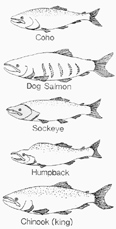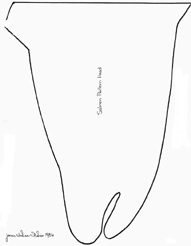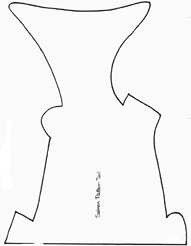 Athabascan
Winter Studies Athabascan
Winter Studies
The Dene'
Indigenous People of Interior
Kindergarten Unit
FNSBSD Alaska Native Education
(DRAFT)
Unit: Athabascan (Dene')
Winter Family Activities Daily and Contemporary Life
Strand
Lesson: Traditional Athabascan (Dene')
Foods
Day 7:
Students will identify various traditional foods Dene'
people gathered, stored, cooked and eaten during the winter
Materials:
Cut out/display pictures of interior Alaska animals and
plants used as food, in natural state and after processing and
storage, you can include salmon, moose, caribou, bear, berries,
birch, ptarmigan, geese, whitefish, beaver, muskrat, porcupine
etc.
Pictures of traps, nets, and other methods used to gather food
Pictures of how foods were stored, cooked and prepared,
traditional and contemporary forms, i.e. from caches to canned
salmon, ("Data Sheet: Traditional
Athabascan Adaptations")
Make copies of whole and dried salmon (2 for each student)
Clothes drying rack or clothesline for hanging paper cutouts of
salmon for smoking
Scissors, paste, stapler, and watercolors supplies (any
colors--let the kids be creative or realistic)
Learning center materials from previous days
Optional food that can be prepared, cooked and stored for
gathering, such as commercially smoked fish, pilot bread, berries
or have a parent make fry bread
Objectives:
Students will learn what foods were gathered, stored and
eaten by the Dene'.
Students will practice language, coloring, cutting and
cooperating skills.
Preparation:
Make copies of whole and open salmon, (2 for each
student), later attach at the top to hang over drying racks
Add learning center w/ fish preparation play, maintain
language, coloring book pages, paper dolls, writing, etc.
Select Athabascan coloring ABC Book pages related to foods
Review Athabascan reference materials, check-out "Data
Sheet: Traditional Athabascan Adaptations"
Prepare commercial foods for tasting
DRY FISH FOR DOGS
COLOR, CUT OUT, GLUE TAILS TOGETHER, AND HANG
THE FISH ON THE RACK.
click on images for a bigger graphic
DRIED EATING
FISH
COLOR, CUT OUT, FASTEN, AND HANG THE
FISH.
click on images for a bigger graphic
Introduction: (set/purpose)
Ask students to brainstorm the main ways people preserve
or keep food for a long time today? Responses will vary but will
include, freezing, canning, drying, etc.
Next, ask them how did the early Athabascans (Dene') preserve
or keep their food before there was electricity and freezers?
Answers may include, smoking, drying, freezing in caches outdoors,
fermenting, etc.
What foods have they learned about in their four winter
stories, answers will include: beaver, bear, caribou, moose,
whitefish and salmon. We will focus on the foods that Athabascans
have been eating for hundreds of years, and we may even get to
taste some, (commercially produced only and notes should go home
first to notify parents that their child will have an opportunity
to sample for commercially prepared salmon and crackers).
Activity: (input)
Re-read/highlight parts of the winter legends used on
days 1-5. Focus the student's attention to information about what
the Dene' people would gather/eat at winter camp
After listening to the Dene' winter camp stories/video,
students will discuss and identify what traditional foods Dene'
families gather and methods used to preserve for winter
Compare to how they obtain, store and prepare food today
Listen for and discuss what animals and other foods a Dene
family would need to live
Explain that all new and old techniques for storage or food
processing tries to preserve the food by drying, (one form of
cooking) and keeping the food from being exposed to the air,
(canning, store in oil, freezing etc.)
Focus on various traditional containers used for storage,
baskets, caches, tied up in trees, root cellars, etc
Compare to modern ways of storing, use lists or photos from
magazines or catalogs, such as the Sears appliances catalog
Discuss the reasons for trying to adapt to the interior winter
by developing ways to make food last all winter
Activity: (guided practice)
Students will make imitation whole and dried fish, one
method that is prepared for storage in a food cache used by the
Dene'.
-Hand out copies of whole salmon for painting or
coloring, cutting, stuffing and stapling, 2 sheets for each
student
-Hand out copies of paper dried fish, 2 sheets for each
student
-Instruct students to cut out both dried fish shapes along
the bold black lines
-The students will water color the fish cut-outs, determine
if they should do before or after cutting
-The two halves of painted fish will be stapled together by
the tail ends so they can hang from the drying racks and be
stacked in the food caches (real dried salmon are stacked in
bundles of 20 lbs. and hung over the rafters in the storage
cache)
-Once the fish are dry and ready they can be hung on lines
in the classroom or in a learning center that looks like a
storage cache
Optional Learning Center Activity:
-for optional food learning center, provide cooking
utensils, empty canned salmon containers, rice, frozen
blueberry box, pilot bread crackers box, and their dry fish,
something to look like moose or caribou meat
-cooking center menu, canned salmon and crackers, rice or
potatoes, cut-up boiled dry fish, roast meat and berries for
desert
Activity: (closure)
After group lesson the students will return to learning
centers to work on language activities, copy Dene' words onto
assigned coloring page of coloring books, play center with paper
dolls, with the addition food preparation activities, additional
center or group activity could include coloring and stuffing the
whole salmon.
Activity: (independent practice)
Students rotate into learning centers
Work in their Athabascan ABC Coloring Book
Practice their Dene' words / phrases / expressions by using the
word cards to work alone or in a small group for practice
Play cooking and food preparation
Listen or tell stories, one child could play the Elder who is
the storyteller with paper doll acting as the children
Watercolor paint and cut-out paper fish
FIVE TYPES OF
SALMON

click on image for a bigger graphic
SALMON PATTERN
CUT OUT THE HEAD AND JOIN TO TAIL TO MAKE WHOLE SALMON PATTERN.
click on images for a bigger graphic

|

|
|
SALMON
PATTERN-HEAD
|
SALMON PATTERN-TAIL
|
Introduction
ANE Curriculum
Overview
Unit Overview
Athabascan
Art Sampler
OCR SCANNED MATERIAL
|